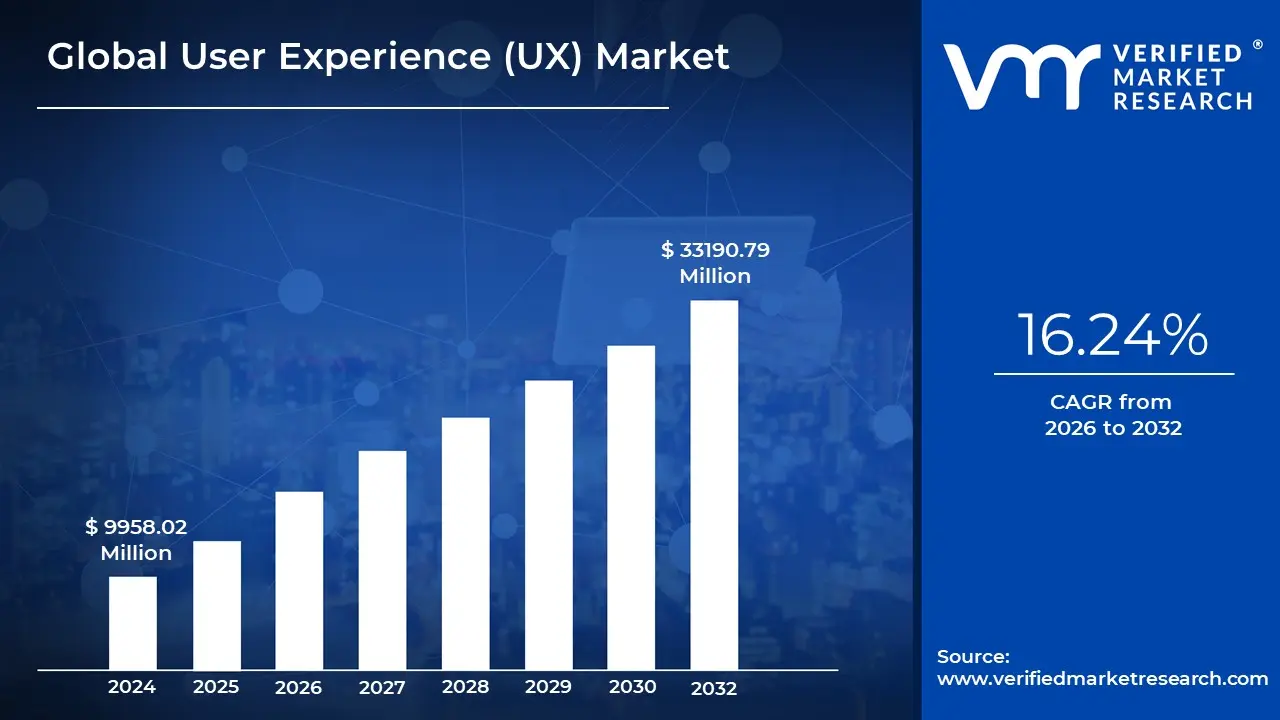Quick Summary :- This blog highlights the five most common UX design challenges faced by modern designers, such as usability, accessibility, and consistency. It also provides practical solutions to address these issues, helping teams create intuitive, engaging, and user-centered digital experiences that enhance satisfaction and performance in 2025.
In today’s competitive digital landscape, creating a seamless and engaging user experience (UX) has become a top priority for businesses. A well-designed UX can make the difference between a product’s success and failure.
According to recent market research, the global User Experience (UX) market size is projected to reach USD 33,190.79 million by 2032, reflecting the growing demand for intuitive and user-friendly digital products.

However, designing an exceptional UX is not without challenges. From maintaining design consistency to addressing accessibility and performance issues, designers often face multiple obstacles that can impact user satisfaction. This blog discusses the top 5 UX design challenges and provides actionable solutions to overcome them effectively.
Fallacies of the profession
A lack of insight into what UX designers do is one of the most common challenges they encounter.
The multidisciplinary nature of user experience design is usually ignored; for many people, the word “user experience design” simply implies “making things look nice.” The market importance of UX, on the other hand, is often overlooked. It can be difficult if basic stakeholders are unaware of your position, i.e., UX designer.
To put it another way, UX design is a highly collaborative position that necessitates buy-in from almost everyone in the company.
Being a UX designer, you can meet with company leaders to get a sense of their vision, and you can rely on the customer service team for useful user feedback. It can be difficult to engage the right people if you are unsure about what you do and why it is relevant.
Suppose you have been hired to create an app. All you have to do now is take care of the design. The company already knows who its customers are and what they want. During the testing process, however, you can discover new information about the user.
Solution
A UX designer must set goals early on. Begin each new project while having a proper conversation with stakeholders, in which a UX designer will describe its position and the project’s goal. Provide daily updates and opportunities for colleagues to ask questions as the project progresses.
Above all, avoid the temptation to protect your job. Invite someone to hear about what you do, whether it is over a casual lunchtime conversation or a formal workshop. Encourage an open-door atmosphere to dispel any myths about what you do.
Researching under time and financial constraints
The two crucial aspects that influence not only design but the entire development cycle are budget and time; both are related to each other. At some point, there can be a shortage of time and resources to perform user research. It is a popular stumbling block.
Everything is associated with a good design, and color layers serve various purposes as well. As a result, even minor changes need more effort, additional work, or costs from designers. When designers are short on time, they are unable to concentrate adequately on the needs of their customers, resulting in less artistic input.
Solution
It is never recommended to skip the initial user research phase since the research process can provide an appropriate solution. Fortunately, many UX designers have been down this road before, and there are plenty of tried-and-true methods for performing fast but successful research on a shoestring budget.
Concentrate on combining the resources and streamlining the process as much as possible. Guerrilla science, which can be used to scale down almost any research tool, is becoming increasingly popular.
As more businesses recognize the importance of UX research, “guerilla” approaches have become a common way to fit research into tight budgets and timelines. This sometimes entails a reduction in depth and/or rigor.
The secret to guerilla research success is striking the right balance between meeting time and budget targets while also being thorough enough to gain useful feedback.
Design-Development Gap
In the process of creating a product, both developers and designers play important but distinct roles. Development is useless without design, and design is useless without development. As a result, a collaboration between the two is needed.
One area that can be particularly challenging is the exchange of design to development. A UX designer’s approach to problem-solving differs from that of developers. Although the designer considers the user’s journey, the developers try to determine what is technically feasible.
Both the product and the process will suffer if developers and designers are not on the same page. Extra feedback loops, unexpected quality assurance challenges, and different perceptions of similar targets are all caused by knowledge gaps and a lack of communication.
Solution
Early and frequent communication between the design and development team is the best way to prevent conflict. As soon as possible, involve the developers; this way, they will be able to spot any potential problems before the handoff.
Sharing knowledge is also important; while you do not have to learn to code, it is worth taking the time to understand how developers function and the challenges they face. Tools such as Zeplin, InVision, and Avocode were created to make the handoff process easier.
Deciding which issue to address
Curiosity and a burning desire to solve problems propel you as a UX designer. The more insights gained by UX designers, the more challenges they will face; eventually, the more difficult it will be to choose only one.
“One of the main challenges of becoming a UX designer is choosing which issue to solve,” says Jeffrey Humble, Head of Design at CareerFoundry.
Furthermore, projects with a simple problem statement can be difficult to complete because there might be a need to resolve any issues that emerge during customer and stakeholder interviews. But time is limited, and there are many problems that come up and are required to be solved in a single project.
UX designers cannot stop running into new problems along the way, so they cannot change the path every time. The key for designers is to stay focused, and the problem statement can help them to carry out the project.
Solution
A great solution to the wrong problem, in the words of Don Norman, can be worse than no solution at all. Good designers never begin by attempting to solve the dilemma that has been presented to them; instead, they begin by attempting to comprehend the true issues.
Take the time at the start of any UX project to define the problem statement. Setting a manageable problem statement will assist UX designers in keeping their wandering eyes focused when they come across shiny new issues. The problem statement will help in getting back on track if getting off track.
Navigating the ever-changing landscape of UX job roles
Another issue that UX designers face is the almost endless number of UX roles. User interface design is such a broad discipline that it has branched out into many different fields of specialization over time.
Information architects, UX writers, UX researchers, and usability analysts are among the professionals that companies are increasingly recruiting to concentrate on specific aspects of UX.
Even when considering the general job title of UX designer, there are some new words to be aware of, such as the increasingly common full-stack designer.
As a result, establishing a place in the industry can be difficult. First, there is the decision on whether to specialize or generalize, which is not necessary to make right away. Then there is the issue of the UX job market’s contradictory names, titles, and terminologies.
Solution
It is critical to stay informed whether to decide on the next career step or define the position within the current business. Look for UX jobs on work boards, such as LinkedIn, Indeed, and many more to get an idea of what employers are looking for right now.
In the United States, for example, positions like user experience researcher, UI/UX designer and creator, product owner, and brand designer can be shown while looking for user experience designer jobs.
With thorough research, it becomes possible to get a sense of the skills and obligations that come with different job titles. This will help an individual to build the brand as well as become a UX expert.
Conclusion
Creating an effective UX design isn’t just about aesthetics, it’s about understanding users, anticipating their needs, and designing seamless digital experiences. Overcoming UX challenges like accessibility, usability, and performance requires a thoughtful balance between creativity and functionality.
As user expectations evolve, businesses that invest in solving these UX design challenges will gain a competitive edge. A well-structured, user-centered approach not only enhances satisfaction but also drives engagement, loyalty, and long-term growth.
-
What is the biggest challenge in UX design today?
The biggest challenge is balancing user needs with business goals while maintaining accessibility, performance, and consistency across all devices.
-
Why is UX design important for business success?
A strong UX improves user satisfaction, increases conversion rates, and helps retain customers, directly impacting business growth and profitability.
-
How can companies overcome UX design challenges?
By conducting user research, continuous testing, and iterative design improvements, companies can identify and fix pain points early in the process.
-
What tools are most useful for UX designers?
Popular tools include Figma, Adobe XD, Sketch, InVision, and Hotjar for designing, prototyping, and testing user experiences.
-
How does accessibility fit into UX design?
Accessibility ensures that digital products are usable by everyone, including people with disabilities, an essential part of delivering inclusive and effective UX design.



